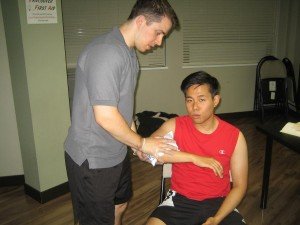Acute wounds include those that are newly acquired and in the initial phase of healing. These wounds are embodied by skin layers that were broken or punctured via an exterior force or object.
https://www.youtube.com/watch?v=d411Ig_F3bQ
Any acute wound can develop into a chronic one if it does not heal within the expected time span or as an outcome of poor blood supply, nutrients, oxygen or hygiene. Acute wounds must be properly treated to prevent infection, inflammation or continuous pressure.
Types of acute wounds
- Abrasions – these wounds are caused by friction with objects or surfaces that scrape off the upper skin layer. Most cases are shallow and irregular in shape with minimal pain and bleeding.
- Puncture wounds – these are rounded, small wounds caused by penetrating objects such as nails or needles. Pain and bleeding are minimal and subside shortly after the removal of the object.

After cleaning, the wounds must be closed using stitches, skin adhesive bands, staples and sterile bandage dressing with or without the application of a topical antibiotic ointment. - Lacerations – these are tear-like wounds deeper than abrasions usually from blunt trauma or direct blow from objects or collisions. The skin is torn irregularly and there is evident pain and bleeding.
- Incision wounds – these are described clean slashes from sharp items such as scalpels, knives and scissors. The cuts are in lines with regular limits and can be superficial or deep. These wounds can be very painful and even dangerous, particularly if a vital organ is involved.
- Gunshot wounds – these are caused by firearms characterized by rounded, regular edges that are smaller than the bullet. There might be burn marks on the perimeters and surrounding tissue.
- Burn wounds
Management
Generally, the treatment for acute wounds involves 2 steps:
Wound cleaning
Acute wounds must be cleaned using warm water and soap before flushed with sterile solution to get rid of any bacteria or contaminated debris. Surgical debridement of the wound is needed to get rid of the dead tissue and any foreign material.
Proper wound cleaning minimizes the risk for infection and promotes the healing process by providing the healthy tissue with a clean environment.
Wound closure
After cleaning, the wounds must be closed using stitches, skin adhesive bands, staples and sterile bandage dressing with or without the application of a topical antibiotic ointment.
Closure of the wound is required to bring the separated tissue together and cover the exposed tissue to minimize the risk of infection and promote the healing process. Nevertheless, diseased surgical wounds are left open after a surgical procedure until the infection settles.
In some instances, a tetanus shot, anti-inflammatory or analgesic pain medications and systemic antibiotics are given as prophylaxis to prevent complications as well as improve the quality of life as the wound heals.
Quick Note / Disclaimer
The material posted on this page on atypical wounds is for learning and educational purposes only. To learn to recognize atypical wounds and how to perform proper wound care, register for a standard first aid course with Edmonton First Aid.

